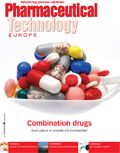Successful packaging of aseptically prefilled products
Pharmaceutical Technology Europe
Why correctly calibrating a drug with its packaging is the key to success.
Why is accurate packaging and process calibration such an essential component of a successful aseptically prefilled injection system?
Properly calibrating a drug with its packaging is one of today's most critical processes in providing high-quality aseptic filling solutions. Increasingly complex drug molecules are making more and more demands on the composition of injection systems while regulatory authorities worldwide are also tightening safety laws. To complicate the situation further, drug manufacturers and users alike are calling for more patient-friendly application systems.

Paul Nelles
Many of these demands cannot be satisfied without packaging solutions that are perfectly calibrated to the specific needs of the substances involved. These solutions will allow an aseptically prefilled product to remain stable in the injection system until it is administered.
Many substances are sensitive to the materials and components used for packaging, and substances can often interact with rubber stoppers, closure systems and other related components in ways that will unintentionally alter the product's parameters and performance characteristics.
Production processes also influence the active substance, which means packaging materials and pharmaceutical processes must also be perfectly calibrated with the active substance. Failing to correctly calibrate packaging and processes can significantly alter the effectiveness (and the outcome) of any aseptic filling solution.
To be successful, how should the packaging and calibration process for aseptically prefilled products be structured?
To ensure all packaging and required processes are harmonized, a number of steps must be taken — none can be overlooked without risking a less than acceptable outcome. Below is a brief overview of the most critical steps.
• Approach packaging and associated filling processes as a whole, rather than separately.
With development times for drugs averaging up to 10 years, costing hundreds of millions of euro and requiring countless complicated processes, packaging and filling concerns are often approached in isolation. This can be a serious mistake because harmonizing packaging and filling processes from the very beginning is one of the best ways of minimizing unforeseen problems later on. Your project team should always include experts in both packaging and filling who work closely together in all phases of strategic planning, process development and production to minimize risks at either end.
• Make a clear assessment of a drug substance's specific features and relevant interactive properties.
Examining a substance's specific features and determining how they interact with all the other components is a critical element of success. For example, silicone is a material commonly used to lubricate stoppers and glass containers prior to insertion into the syringe; however, silicone has been associated with protein inactivation. Certain solutions may also be sensitive to light or moisture, which can alter the specific features of a product. Unless a clear assessment is made of how substances and components will react to each other, your desired outcomes can be seriously compromised.
• Develop efficient and effective production processes early.
The need for efficient and effective production processes may seem an obvious requirement, but developing production efficiency can often be inadvertently overlooked, especially if production processes are not considered until the very last stages of a product's launch. As an example, to maximize efficiency and minimize unnecessary costs, processes needed for filling must be individually evaluated and developed for every product separately. In fact, regardless of the product in question, a number of steps must be carefully evaluated and calibrated to ensure maximum efficiency. Thawing procedures, handling, mixing and filtration, for example, must all be taken into consideration.
Other issues include: "What type of tubing will be used?" "What is the maximum filtration pressure allowed?" "Has the filling been checked against the type of pumping system being used?" Answering such questions prior to production and ensuring these procedures are in place helps create a more efficient, manageable and profitable production process.
Simulate production conditions in the laboratory.
One of the best ways to achieve the results you want is to simulate production conditions in a laboratory before the actual manufacturing process begins. This not only allows you to develop and test production processes in a real-world scenario, but provides a cost-effective way to identify and correct potential errors prior to the manufacturing stage of the product launch.
• Transfer the project to commercial production.
After all testing and laboratory studies have been completed, you are ready to transfer the product to the commercial production stage. If all previous steps have been managed thoroughly and professionally, the transfer will be a straightforward and, most importantly, highly successful process.
Are the packaging and processing harmonization requirements different for chemical substances than they are for biologicals?
The need for harmonization is equally important for all pharmaceutical substances, chemical or biological. However, the challenge is particularly prevalent with highly complex biotech substances because most biopharmaceutical drugs are extremely sensitive to their environment.
All materials that are used in relation to a biopharmaceutical drug (e.g.,type of glass, various contact parts and components, degree of siliconization, etc.) must be optimally matched with the respective active substances to ensure effectiveness. Packaging and processing calibration is no more critical to the success of a biotech product than it is to a chemical drug, but it can sometimes be measurably more complex.
Paul Nelles is Vice President Development Services at Vetter Pharma-Fertigung GmbH & Co. KG (Germany).

Drug Solutions Podcast: A Closer Look at mRNA in Oncology and Vaccines
April 30th 2024In this episode fo the Drug Solutions Podcast, etherna’s vice-president of Technology and Innovation, Stefaan De Koker, discusses the merits and challenges of using mRNA as the foundation for therapeutics in oncology as well as for vaccines.